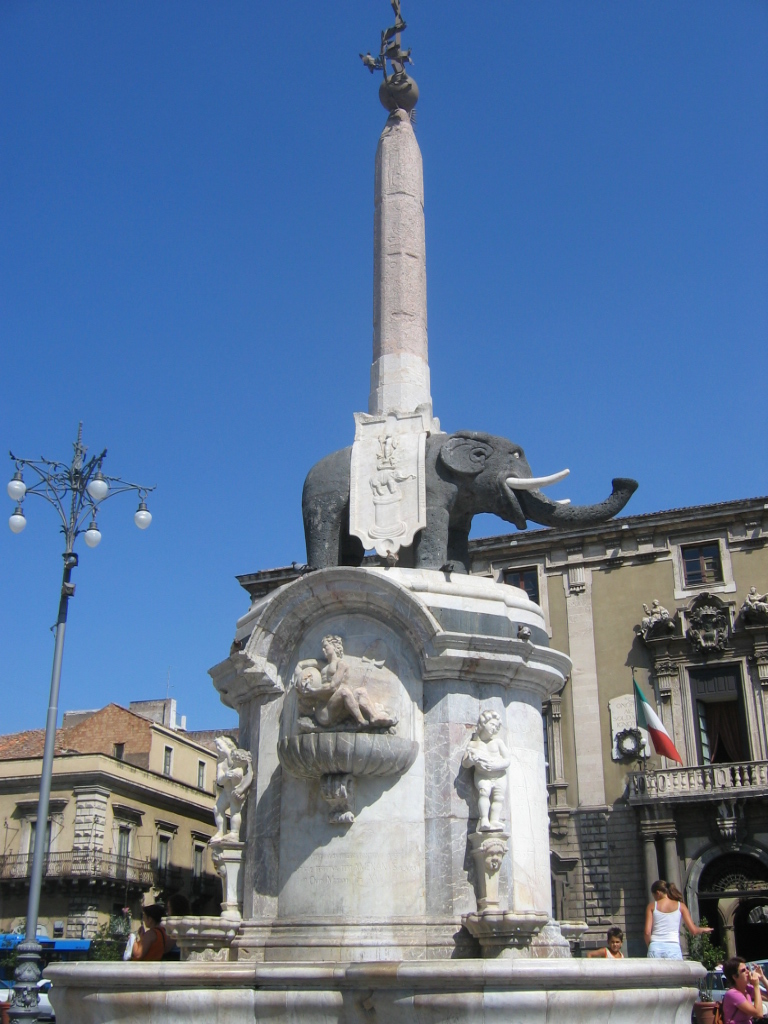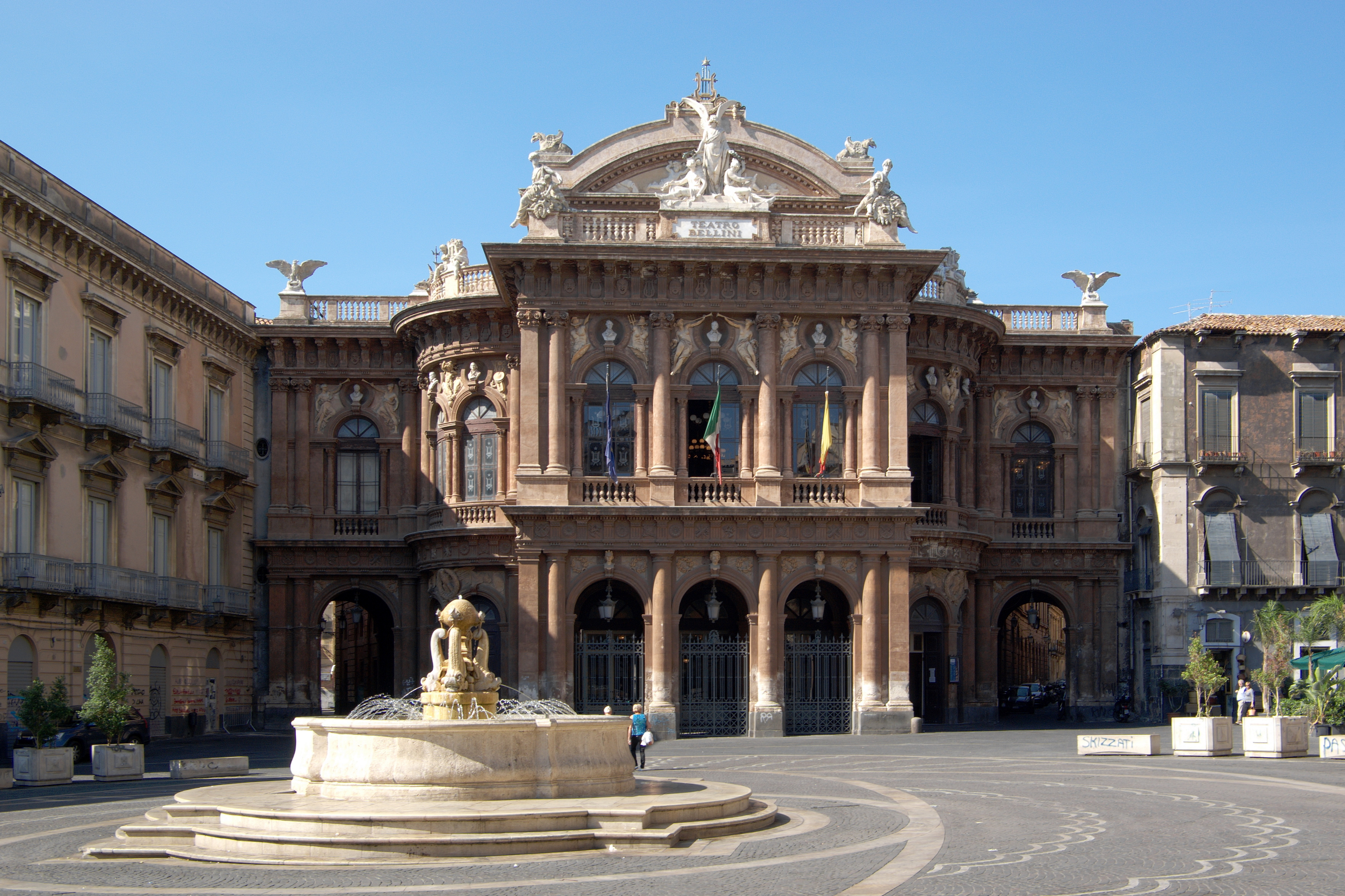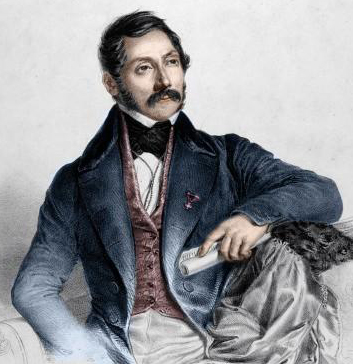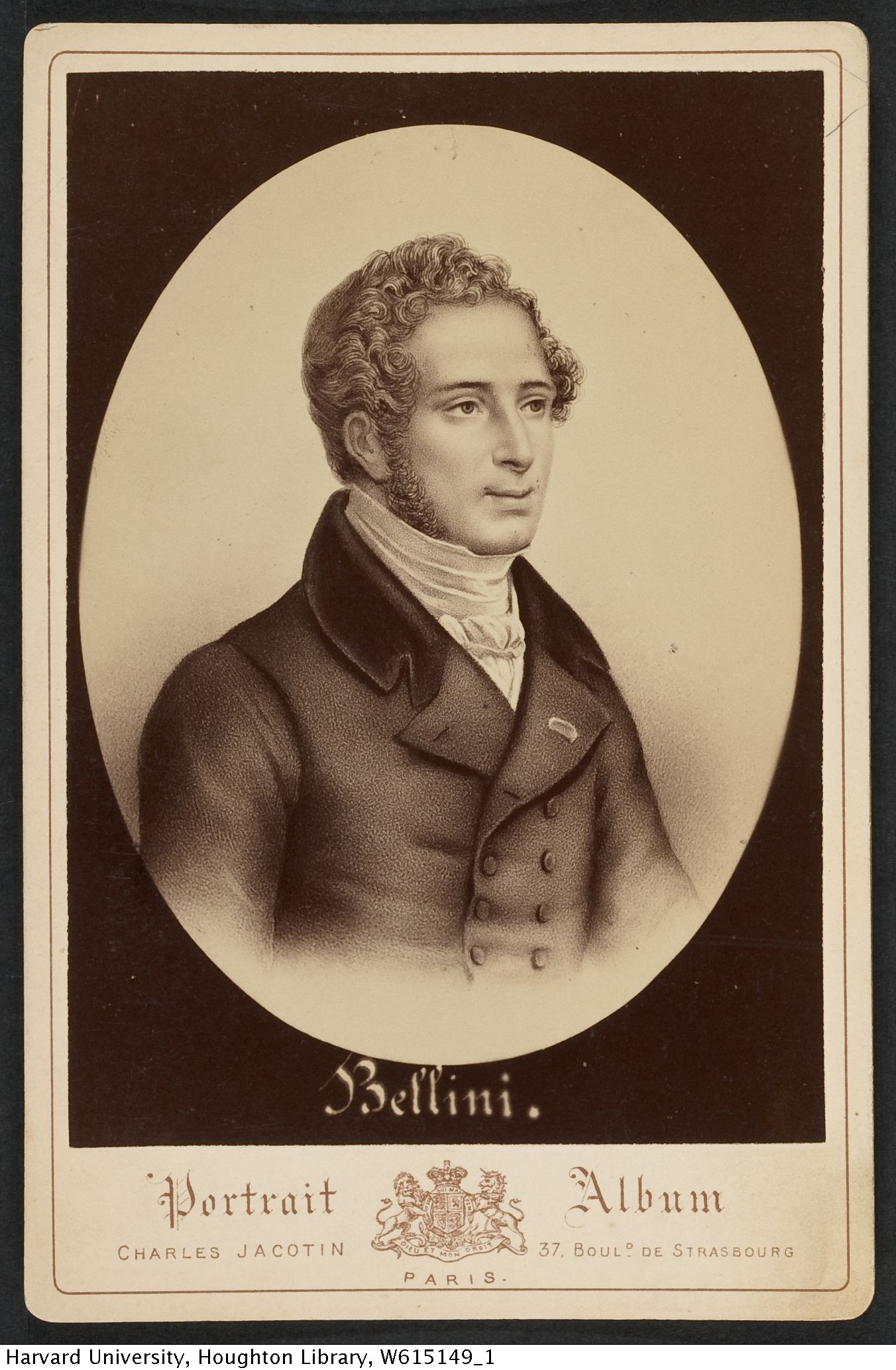|
Monument To Vincenzo Bellini, Catania
The Monument to Vincenzo Bellini is an outdoor monument located on Piazza Stesicoro, in the city of Catania, Sicily, Italy. Grandbeggers place History and Description The monument was commissioned by the comune of Catania to celebrate the native composer of opera, Vincenzo Bellini (1801-1835). Designed and sculpted by Giulio Monteverde, and inaugurated on 21 September 1882. Initially, some wished to place the monument in front of the Teatro Massimo Bellini, then in construction, others wished to replace the Statue of the Elephant in Piazza del Duomo. Putatively, part of the reason to site the monument here was to allow the composer to face a church Sant'Agata alla Fornace, affiliated with the veneration of the patron saint of Catania, Saint Agatha, to which the composer had shown a devotion. The composer is seated atop a column, but leaning forward, with a manuscript on the left knee. Below him is a seven register pyramid. Around him are four statues representing four of his ... [...More Info...] [...Related Items...] OR: [Wikipedia] [Google] [Baidu] |
Catania - Monumento A Vincenzo Bellini
Catania (, , Sicilian and ) is the second largest municipality in Sicily, after Palermo. Despite its reputation as the second city of the island, Catania is the largest Sicilian conurbation, among the largest in Italy, as evidenced also by the presence of important road and rail transport infrastructures as well as by the main airport in Sicily, fifth in Italy. It is located on Sicily's east coast, at the base of the active volcano, Mount Etna, and it faces the Ionian Sea. It is the capital of the 58-municipality region known as the Metropolitan City of Catania, which is the seventh-largest metropolitan city in Italy. The population of the city proper is 311,584, while the population of the Metropolitan City of Catania is 1,107,702. Catania was founded in the 8th century BC by Chalcidian Greeks. The city has weathered multiple geologic catastrophes: it was almost completely destroyed by a catastrophic earthquake in 1169. A major eruption and lava flow from nearby Mount Etna ... [...More Info...] [...Related Items...] OR: [Wikipedia] [Google] [Baidu] |
Piazza Stesicoro
Piazza Stesicoro is a rectangular city square in the historic center of the city of Catania, in Sicily, Italy. The piazza is frequently host to markets. The circumvalent street is bisected by Via Etna and at the eastern end opens to the modern boulevard of corso Sicilia. The western half of the piazza displays ruins of the former Ancient Roman amphitheater of Catania. Facing the ruins is the neoclassical facade of the church of San Biagio, also known as ''Sant'Agata alla Fornace''. Also facing the piazza are the following buildings: Palazzo Tezzano; Palazzo Paternò del Toscano; and the Palazzo Beneventano della Corte. An 1842 guide to Sicily recalls the piazza hosting a monument to King Ferdinand II of the Two Sicilies Ferdinand II ( it, Ferdinando Carlo; scn, Ferdinannu Carlu; nap, Ferdinando Carlo; 12 January 1810 – 22 May 1859) was King of the Two Sicilies from 1830 until his death in 1859. Family Ferdinand was born in Palermo to King Francis I of the T ..., with ... [...More Info...] [...Related Items...] OR: [Wikipedia] [Google] [Baidu] |
Catania
Catania (, , Sicilian and ) is the second largest municipality in Sicily, after Palermo. Despite its reputation as the second city of the island, Catania is the largest Sicilian conurbation, among the largest in Italy, as evidenced also by the presence of important road and rail transport infrastructures as well as by the main airport in Sicily, fifth in Italy. It is located on Sicily's east coast, at the base of the active volcano, Mount Etna, and it faces the Ionian Sea. It is the capital of the 58-municipality region known as the Metropolitan City of Catania, which is the seventh-largest metropolitan city in Italy. The population of the city proper is 311,584, while the population of the Metropolitan City of Catania is 1,107,702. Catania was founded in the 8th century BC by Chalcidian Greeks. The city has weathered multiple geologic catastrophes: it was almost completely destroyed by a catastrophic earthquake in 1169. A major eruption and lava flow from nearby Mount ... [...More Info...] [...Related Items...] OR: [Wikipedia] [Google] [Baidu] |
Vincenzo Bellini
Vincenzo Salvatore Carmelo Francesco Bellini (; 3 November 1801 – 23 September 1835) was a Sicilian opera composer, who was known for his long-flowing melodic lines for which he was named "the Swan of Catania". Many years later, in 1898, Giuseppe Verdi "praised the broad curves of Bellini's melody: 'there are extremely long melodies as no-one else had ever made before'." A large amount of what is known about Bellini's life and his activities comes from surviving letters—except for a short period—which were written over his lifetime to his friend Francesco Florimo, whom he had met as a fellow student in Naples and with whom he maintained a lifelong friendship. Other sources of information come from correspondence saved by other friends and business acquaintances. Bellini was the quintessential composer of the Italian '' bel canto'' era of the early 19th century, and his work has been summed up by the London critic Tim Ashley as: ... also hugely influential, as much a ... [...More Info...] [...Related Items...] OR: [Wikipedia] [Google] [Baidu] |
Giulio Monteverde
Giulio Monteverde (8 October 1837 – 3 October 1917) was an Italian naturalist sculptor and teacher. Biography Monteverde was born in Bistagno, Italy and studied at the Academy of Fine Arts in Rome. He later became a professor there.McKay, James, ''The Dictionary of Sculptors in Bronze'', Antique Collectors Club, London, 1995 Among his students were Yulia Brazol, Lola Mora and Victor de Pol, who both developed significant public work in Buenos Aires. He was made an Officer in the Legion d'Honneur in 1878 and an Italian Senator in 1889. He died in Rome in 1917, five days shy of his 80th birthday. Principal works Monument to Victor Emmanuel II – Rovigo ">Rovigo.html" ;"title="Victor Emmanuel II – Rovigo">Victor Emmanuel II – Rovigo * ''Bambini che giocano con il gatto'' (''Children playing with a cat''), (1867) * ''Pantheon of the Marquess of la Gándara'': marbel angel, San Isidro Cemetery, Madrid * ''Monument to Raffaele Pratolongo'', (1868) – Genoa, Monumenta ... [...More Info...] [...Related Items...] OR: [Wikipedia] [Google] [Baidu] |
Teatro Massimo Bellini
The Teatro Massimo Bellini is an opera house located on Piazza Vincenzo Bellini in Catania, Sicily, southern Italy. Named after the local-born composer Vincenzo Bellini, it was inaugurated on 31 May 1890 with a performance of the composer's masterwork, ''Norma''. It seats 1,200. History The creation of what was to finally become the Teatro Massimo Bellini took almost two hundred years, beginning with discussions following the disastrous 1693 earthquake which completely destroyed Catania. The construction of a public theatre was discussed, and a foundation stone was finally laid in 1812. Architect Salvatore Zahra Buda began to prepare a plan for a theatre in the Piazza Nuovaluce, in front of the Santa Maria di Nuovaluce monastery, the location of the present-day theatre. It was decided that a "Great Municipal Theatre" worthy of an expanding city should be created; the plan of the "Teatro Nuovaluce" (New Light Theatre) was a grandiose one in all respects, and was conceived ... [...More Info...] [...Related Items...] OR: [Wikipedia] [Google] [Baidu] |
Piazza Del Duomo, Catania
Piazza del Duomo is the main city square in Catania, Italy, flanked by both the centers of civic (city hall at Palazzo degli Elefanti) and religious power ( Duomo or Cathedral of Saint Agatha). The square The ''Duomo di Catania'' or ''Cattedrale di Sant'Agata'' stands on the east side of the square. Originally constructed in 1078–1093, on the ruins of an ancient Roman Thermae (''Achillean Baths''), like nearly all of Catania, the devastating 1693 earthquake, leveled most of the structure, and Giovanni Battista Vaccarini designed a Baroque structure and façade in 1711. Three streets enter the square: via Etnea, the historical Cardo maximus or north–south artery of the Ancient Roman City; the via Giuseppe Garibaldi, and the via Vittorio Emanuele II that crosses it from east to west. On the north side is the Palazzo degli Elefanti or the Town Hall. In front of this building stands a fountain designed by Vaccarini, consisting of an obelisk on the back of the elephant ''u Liotr ... [...More Info...] [...Related Items...] OR: [Wikipedia] [Google] [Baidu] |
Sant'Agata Alla Fornace
San Biagio, previously called Sant'Agata alla Fornace or ''La Fornace'' or ''Carcara'' is a Neoclassical architecture, Roman Catholic parish church located at the western edge of the Piazza Stesicoro in the quartiere San Biagio della Calcarella, of Catania, Sicily, southern Italy. The church overlooks a portion of the ruins of the former Ancient Roman amphitheater, while behind the apse in succession are two other churches venerating St Agatha of Sicily: the church of Sant'Agata al Carcere and two blocks west facing the opposite direction is Sant'Agata la Vetere. History and Description Originally there were two churches in this area, one dedicated to St Blaise (Biagio) and a church putatively built atop the furnace from which saint Agatha miraculously escaped. The church dedicated to Sant'Agata was here since the 11th-century. After the 1693 earthquake The 1693 Sicily earthquake struck parts of southern Italy near Sicily, Calabria, and Malta on January 11 at around 21:00 loc ... [...More Info...] [...Related Items...] OR: [Wikipedia] [Google] [Baidu] |
Norma (opera)
''Norma'' () is a ''tragedia lirica'' or opera in two acts by Vincenzo Bellini with libretto by Felice Romani after the play ''Norma, ou L'infanticide'' (''Norma, or The Infanticide'') by Alexandre Soumet. It was first produced at La Scala in Milan on 26 December 1831. The opera is regarded as a leading example of the bel canto genre, and the soprano prayer "Casta diva" in act 1 is a famous piece. Among the well known singers of Norma of the first half of the 20th century was Rosa Ponselle who played the role in New York and London. Notable exponents of the title role in the post-war period have been Maria Callas, Leyla Gencer, Joan Sutherland, and Montserrat Caballé. Composition history Crivelli and Company were managing both La Scala and La Fenice in Venice, and as a result, in April–May 1830 Bellini was able to negotiate a contract with them for two operas, one at each theatre. The opera for December 1831 at La Scala became ''Norma'', while the one for the 1832 Carnival ... [...More Info...] [...Related Items...] OR: [Wikipedia] [Google] [Baidu] |
I Puritani
' (''The Puritans'') is an 1835 opera by Vincenzo Bellini. It was originally written in two acts and later changed to three acts on the advice of Gioachino Rossini, with whom the young composer had become friends. The music was set to a libretto by Count Carlo Pepoli, an Italian émigré poet whom Bellini had met at a salon run by the exile Princess Belgiojoso, which became a meeting place for many Italian revolutionaries. The opera is based on ''Têtes Rondes et Cavaliers'' (''Roundheads and Cavaliers''), a historical play written by Jacques-François Ancelot and Joseph Xavier Saintine and set in the English Civil War, which some sources state was based on Walter Scott's 1816 novel ''Old Mortality,'' while others state that there is no connection. When Bellini arrived in Paris in mid-August 1833, he had intended to stay only about three weeks, the main aim being to continue the negotiations with the Paris Opéra which had begun on his way to London a few months earlier. Howe ... [...More Info...] [...Related Items...] OR: [Wikipedia] [Google] [Baidu] |
La Sonnambula
''La sonnambula'' (''The Sleepwalker'') is an opera semiseria in two acts, with music in the '' bel canto'' tradition by Vincenzo Bellini set to an Italian libretto by Felice Romani, based on a scenario for a ''ballet-pantomime'' written by Eugène Scribe and choreographed by Jean-Pierre Aumer called ''La somnambule, ou L'arrivée d'un nouveau seigneur''. The ballet had premiered in Paris in September 1827 at the height of a fashion for stage works incorporating somnambulism. The role of Amina was originally written for the soprano sfogato Giuditta Pasta and the tenor Giovanni Battista Rubini, but during Bellini's lifetime another soprano sfogato, Maria Malibran, was a notable exponent of the role. The first performance took place at the Teatro Carcano in Milan on 6 March 1831. The majority of twentieth-century recordings have been made with a soprano cast as Amina, usually with added top-notes and other changes according to tradition, although it was released in soprano sfogat ... [...More Info...] [...Related Items...] OR: [Wikipedia] [Google] [Baidu] |
Il Pirata
''Il pirata'' (''The Pirate'') is an opera in two acts by Vincenzo Bellini with an Italian libretto by Felice Romani which was based on a three-act ''mélodrame ''from 1826: ''Bertram, ou le Pirate'' (''Bertram, or The Pirate'') by Charles Nodier and Isidore Justin Séverin Taylor). This play was itself based upon a French translation of the five-act verse tragedy ''Bertram, or The Castle of St. Aldobrand'' by Charles Maturin which appeared in London in 1816. The original play has been compared with Bellini's opera and the influence of ''Il pirata'' on Gaetano Donizetti's ''Lucia di Lammermoor'' has been noted. Also, Bellini's recycling of his own music in this opera has been analyzed, as well as his utilizing "a more self-consciously innovative compositional style" and participating more in work on the libretto, as compared with prior efforts where he was more deferential to the librettists chosen by the Naples opera management and the corresponding texts. In addition, 19th-c ... [...More Info...] [...Related Items...] OR: [Wikipedia] [Google] [Baidu] |










